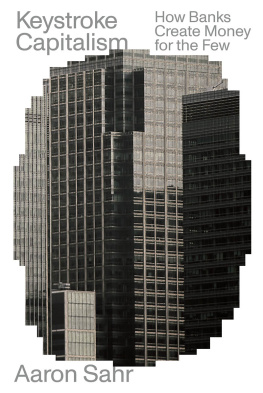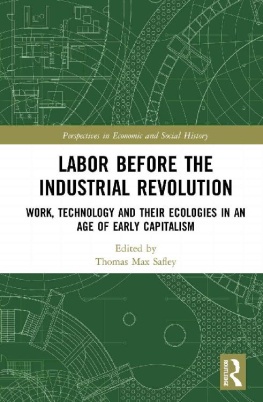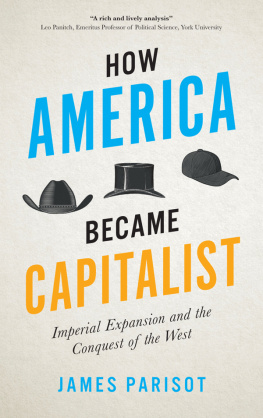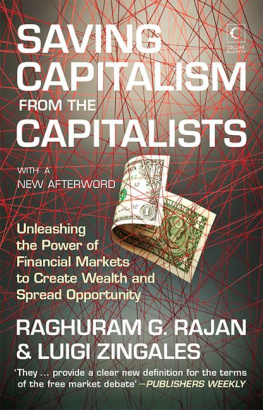PERMANENT REVOLUTION
Reflections on Capitalism
WYATT WELLS
stanford briefs
An Imprint of Stanford University Press
Stanford, California
Stanford University Press
Stanford, California
2020 by the Board of Trustees of the Leland Stanford Junior University.
All rights reserved.
No part of this book may be reproduced or transmitted in any form or by any means, electronic or mechanical, including photocopying and recording, or in any information storage or retrieval system without the prior written permission of Stanford University Press.
Printed in the United States of America on acid-free, archival-quality paper
Cataloging-in-Publication Data is available upon request from the Library of Congress.
Library of Congress Control Number: 2020931103
Cover design: Christian Fuenfhausen
Typeset by Classic Typography in 11/15 Adobe Garamond
ISBN: 9781503612389 (ebook)
CONTENTS
PREFACE: REFLECTIONS ON CAPITALISM
Capitalism rewrites the human narrative. For most of recorded history, the population lived within narrow confines. Almost half died in childhood, and those who survived to their teens could expect to live into their forties, on average. Most could not read or write. In good times, the majority enjoyed a few luxuries, but most were only two or three bad harvests from destitution. Output expanded slowly, and population growth absorbed a large portion of the gain. Occasionally, disasters like the collapse of the Western Roman Empire, the Mongol invasions, or the Black Death undid the work of generations. These societies were hierarchical, with individuals occupying a well-defined position determined in most cases by birth. In theory, a central idealRoman virtue, Confucian order, Christian pietygoverned these relationships. History recounted humanitys effort to realize these principles.
In the last three centuries, the human condition has changed beyond recognition. Though population has expanded many-fold, living standards have increased sharply. Luxuries such as electric lights, automobiles, and smartphones, unknown in earlier ages, are common. The large majority of children reach adulthood, and for the first time most of the population can read and write. Moral advances have accompanied material ones. By the early twenty-first century, every country in the world had formally banned slavery, and most had substantially expanded the rights of women.
The change began in Britain in the eighteenth century, spreading from there to Western Europe and North America and then to other parts of the globe, most notably Japan and South Korea. Historians and economists have christened this transformation the Industrial Revolution, but it is better understood as capitalist development. Entrepreneurs, in their relentless pursuit of profit, commercialized one innovation after anotherpower looms, steam engines, railroads, electric lighting, automobiles, plastics, integrated circuits, and much more. In so doing, they reshaped the economic landscape, not once but over and over again. This process created wealth in new and often unexpected places and constantly reshuffled the population, disrupting the inherited order. In its place, capitalism offered progressan ever-rising standard of living and liberation from traditional constraints. The certainties of centuries gave way, not to a new set of verities but to a world in which nothing seemed settled: to a permanent revolution.
PART 1
CAPITALIST DEVELOPMENT
Capitalism has no father. No individual or group conceived of and created it. No one even coined the word capitalism until the system it connotes dominated the economic life of entire nations. What we call capitalism developed gradually, over centuries, from the actions of people pursuing their own interests without much thought for the broader implications. Capitalists are a distinct type. They organize their business to secure the highest economic return, and when conditions change because of shifting markets or new technology, they reorganize their affairs to suit. Often, capitalists themselves, in the search for new opportunities, set these changes into motion. The object is material wealth, not political power, social status, or spiritual enlightenment. Capitalists tend to be unsentimental and optimistic, with their eyes set on future opportunities rather than past precedents. Most definitions of capitalism emphasize institutions like private property, free markets, and the rule of law, and indeed all capitalist societies possess these. Yet they are not capitalism any more than a well-maintained aquarium is a fish. Capitalism exists where the values of the capitalist pervade economic life.
THE CAPITALIST BREAKTHROUGH
From the dawn of history until well into the twentieth century, most people were peasantssubsistence farmers living in tightly knit communities. Survival depended on common effort. Such was particularly true in the great river basins of the Middle East, India, and China, which relied on irrigation, but even in regions of dry farming like Europe, planting and the harvest required that the entire community work together. Peasant communities had a variety of social gradations, ranging from those who enjoyed some luxuries to others who had barely enough to survive, but most of the time a sense of common interest overrode such divisionsparticularly when it came to dealing with outsiders.
Although peasants usually generated a surplus, they faced a constant struggle with landlords and tax collectors eager to appropriate it. This classfor the lack of a better term, the gentrysometimes planned and coordinated valuable public works like irrigation projects, but for the most part it contributed little to economic life, instead focusing on government and culture. The elites levies financed art, literature, religion, and philosophy, and it usually cited these accomplishments as proof of its superiority to the peasantry, on which it depended. Yet the gentrys own language often revealed the ugly truth of exploitation. Russian landlords spoke of screwing money out of peasants; Chinese mandarins devised squeezes to get cash; and medieval European nobles used Bad Customs to extract payments from villages. A wide variety of social gradations existed within the gentry, but with respect to the peasantry, most recognized their common interest in maintaining control.
The gentry were not capitalists. Their primary occupation was politics, and most invested whatever surplus they had in political or cultural pursuits. The rulers described in the Iliad and Beowulf used their wealth to secure and reward followers; Egypts pharaohs built pyramids and temples; and medieval Europes elite constructed castles and endowed monasteries and cathedrals. When members of the gentry did invest for income, they usually bought more land farmed by more peasants.
Even had some of the gentry wanted to become rural capitalists, they would have faced daunting obstacles. The communal nature of farming and the constant struggle between peasants and gentry encouraged the development of incredibly complex systems of ownership for societys chief economic asset: farmland. Sometimes villages owned land in common, with different families having the right to grow crops on certain portions of the common patrimony, while other parts, like meadows, were open to all. A landlord would usually receive rent from the village and perhaps other benefits as well, such as the labor of peasants for one or two days a week in fields that he farmed himself. In other cases, one individual collected rent from land while another had the right to farm it, a right he could lease to a third party. Each societysometimes it seems each villagehad its own rules, but the point was always the same: to eliminate conflict among villagers and between them and the gentry by specifying clearly who was entitled to what. Unfortunately, harmony proved elusive because all interpreted, or reinterpreted, the rules in their own favor, and each conflict usually spawned a new set of rules. Generally, the more advanced and stable a society, the denser the network of rules governing land.








